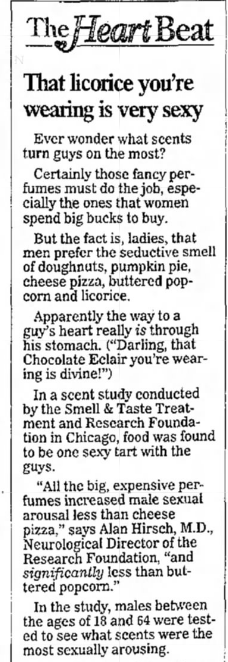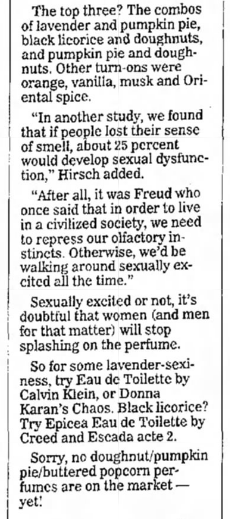1990s
Best Scents for Sexual Arousal
The article dates from 1997 (The Daily Herald Chicago, Illinois 21 Aug 1997, Thu Page 97), but an actual scientific paper from the same people was posted in 2014. If any WU-vie can cite more recent reasearch, please do so!

Posted By: Paul - Sun May 16, 2021 -
Comments (4)
Category: 1990s, Twenty-first Century, Smells and Odors, Sex
Jan Švankmajer’s “Lunch”
Creator's Wikipedia page.
Posted By: Paul - Sun May 02, 2021 -
Comments (2)
Category: Food, Movies, Surrealism, 1990s, Eating
The Stimulator
The Stimulator, which sold for $79, promised to cure headaches, allergies, swollen joints, backaches, and more. It did this by delivering low-voltage electrical shocks to whatever body part was hurting.However, the FDA shut down its manufacturer in 1997 noting that the device was actually a modified gas-grill igniter which cost about $2 to make.
More info: Museum of Quackery


Greenville News - Jan 21, 1997
Posted By: Alex - Fri Apr 23, 2021 -
Comments (2)
Category: Patent Medicines, Nostrums and Snake Oil, 1990s
Roger Powell, Human Work of Art
In 1995 Roger Powell was 46 years old and living homeless on the streets of London after the failure of his taxi business. And then, by a strange twist of fate, his life changed and he became a work of art.Film director Tony Kaye had decided to display a homeless person as a work of art at the Saatchi Gallery. So he sent his assistant out to find a homeless person willing to go along with this scheme, and Powell was the one found.

Powell on display at the Saatchi Gallery. Source: alamy.com
Powell sat in the gallery beside a sign explaining that he was for sale as a "human work of art." The price: £1000.
As far as I know, no one offered to buy Powell. Nevertheless, Kaye continued to display Powell at various museums for the next two-and-a-half years, but most of the time not as an official exhibit. Powell would simply walk around the museums while wearing a t-shirt that said "For Sale, Roger, By Tony Kaye, Four Million Pounds." (The sale price had inflated quite a bit.) In return for doing this, Kaye paid Powell a small weekly allowance and gave him some money towards rent.

San Francisco Examiner - Nov 19, 1995
Eventually Kaye lost touch with Powell. Then, in 2002 Powell died. Kaye paid for Powell's cremation and received his ashes. He said he planned to use them to create a painting that would say "Dead Homeless Man." I don't know if he ever completed this work.
More info: upi.com, CSMonitor
Posted By: Alex - Tue Apr 20, 2021 -
Comments (0)
Category: Art, 1990s
The American Airlines Recipe Book
We recently posted about the American Airlines Wine Club, which allows people to enjoy wines served inflight at home. Turns out that in 1994 the company did something similar with its airline food, publishing a recipe book so that people could "prepare their inflight favorites at home". It was titled A Taste of Something Special.The book was given to frequent fliers, rather than being sold to the public. But you can now download a pdf of the entire thing via Michigan State University Library.



Yonkers Herald Statesman - Feb 8, 1996
Posted By: Alex - Wed Apr 14, 2021 -
Comments (8)
Category: Food, Cookbooks, Air Travel and Airlines, 1990s
Anti-Pollution Ventilators
1996: French engineer Yves Lecoffre proposed installing 70,000 "anti-pollution ventilators" (aka fans) around the streets of Paris to blow away the exhaust fumes from cars.Was he joking about this? Was it some kind of April Fool joke? Not as far as I can tell. Though I can't imagine how his scheme would have made the slightest difference to Paris's air quality.

Calgary Herald - May 4, 1996
Posted By: Alex - Tue Apr 13, 2021 -
Comments (3)
Category: Engineering and Construction, Really Bad Ideas, Urban Life, 1990s
Chair Safety
1999: Due to a spate of "chair-related injuries", the employees in the Seattle Police Department's Identification Unit all had to take a training session on how to safely sit in a chair.
I guess chair safety is one of those things that sounds silly, until you hurt yourself sitting down wrong. Below, Regina Cochrane, "professional accident preventer," offers some chair safety tips.
Posted By: Alex - Wed Apr 07, 2021 -
Comments (2)
Category: Accidents, Furniture, 1990s
Uke-TEL NAKI-U1
"Uke-TEL NAKI-U1" is the 1993 creation of the 'art collective' Maywa Denki (brothers Masamichi and Nobumichi Tosa), who specialize in creating "useless machines". They offer the following description of 'Uke-TEL' on their website:Or, as explained by We Make Money Not Art:

Seems to me its use is to kill goldfish, which makes it relevant to the controversy, previously posted about, concerning the legal rights of goldfish.
Posted By: Alex - Tue Mar 30, 2021 -
Comments (0)
Category: Art, Fish, 1990s
Oakland Ballet Battles Virginity
1995: In an effort to attract new customers, "including singles, sports-minded men and female shopping-mall patrons," the Oakland Ballet put up billboards that displayed the message, "Go ahead, take another date to miniature golf, and die a virgin. Oakland Ballet. You just might like it."I can understand that the ads were meant to be controversial, but what was with the weird dig at miniature golf?
More info: LA Times

Sacramento Bee - Nov 23, 1995
Posted By: Alex - Mon Mar 29, 2021 -
Comments (3)
Category: 1990s, Billboards
Nuclear submarines as oil tankers
Potentially mad scheme: After the collapse of the Soviet Union, the Russian navy was casting about for ways to raise revenue and came up with the idea of using Typhoon-class submarines as oil tankers. The Soviets had built six Typhoon-class nuclear subs which were, and still are, the largest submarines ever made. The main selling point of this idea was that the subs could travel under Arctic ice, eliminating the need for expensive ice-breakers. From wikipedia:The idea was abandoned when someone over there decided that a nuclear sub filled with 10,000 tons of oil might pose some safety concerns.
More info: bellona.org

Posted By: Alex - Tue Mar 16, 2021 -
Comments (7)
Category: Military, Atomic Power and Other Nuclear Matters, Transportation, 1990s

| Who We Are |
|---|
| Alex Boese Alex is the creator and curator of the Museum of Hoaxes. He's also the author of various weird, non-fiction, science-themed books such as Elephants on Acid and Psychedelic Apes. Paul Di Filippo Paul has been paid to put weird ideas into fictional form for over thirty years, in his career as a noted science fiction writer. He has recently begun blogging on many curious topics with three fellow writers at The Inferior 4+1. Contact Us |




